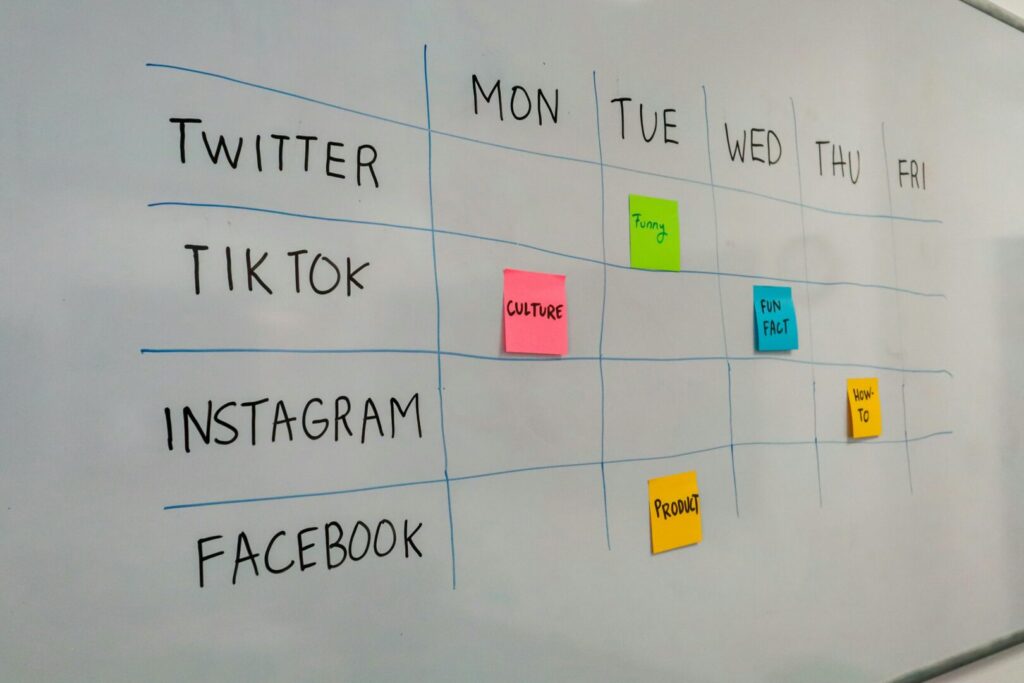Marketing in 2025 has moved far beyond simply posting on social media and hoping the right audience finds you. Today, success is determined by precision, clarity, and measurement. Every campaign, every email, every paid advertisement, and every social post generates data.
Yet data on its own is meaningless unless you know which numbers are worth tracking and how they connect to the bigger picture of growth. That is why understanding and applying the essential KPIs for marketing is no longer optional – it is the difference between a thriving business and one that quietly disappears.

This article explores the role of KPIs in building a powerful and profitable 2025 marketing strategy. We will look at why KPIs matter more now than ever before, how omnichannel strategies make measurement more effective, and which KPIs different industries should prioritize. We will also explore practical checklists for beginners and advanced marketers, showing you how to get started no matter your level of experience. Most importantly, we will show you how to move beyond vanity metrics to focus only on the numbers that truly drive sales, revenue, and customer loyalty.
Why KPIs Matter More Than Ever
Ten years ago, many businesses were still satisfied with looking at broad numbers like follower growth or total website visits. These were easy to measure, but they rarely revealed what was actually moving the needle. In 2025, competition is sharper than ever, customer attention spans are shorter, and algorithms change daily. If you are not laser-focused on the KPIs that directly tie to sales, customer relationships, and brand growth, you are essentially navigating without a compass.
The absence of clear KPIs creates chaos. Marketing teams might run random campaigns without knowing whether they are profitable. Sales teams might chase leads that are not qualified. Customer support might not have the insights they need to solve problems effectively. And leadership might spend budgets on strategies that do not deliver long-term returns.
By contrast, when businesses embrace the essential KPIs for marketing, clarity becomes the norm. You immediately see what works, what does not, and where improvements are necessary. Campaigns feel intentional. Teams are aligned. Budgets are optimized. Customers feel understood and valued because the business is consistently delivering what they need, across every touchpoint.
Read more: How to Get Customers When You’re Starting from Zero in 2025
Omnichannel Marketing: The Heart of KPI Success

One of the most important trends shaping KPI tracking in 2025 is the omnichannel approach. Customers no longer interact with brands in a linear way. A buyer might first see your brand on Pinterest, later read a blog post you published on LinkedIn, receive an email about your new offer, and then finally make a purchase through your website or in a physical location. To the customer, all of these interactions feel like one seamless journey.
This is why omnichannel marketing matters. It ensures that no matter where a customer interacts with you, they experience a consistent voice, consistent messaging, and consistent value. From a KPI perspective, omnichannel marketing gives you a complete view of the customer journey. Instead of measuring Facebook ads in isolation or email campaigns on their own, you are able to see how all channels work together to generate awareness, build trust, and ultimately create conversions.
The benefits of omnichannel KPI tracking are powerful. Customers enjoy a unified brand experience. Conversion rates improve because each touchpoint supports the other. Departments across the business – from marketing to sales to customer support – work with the same data and success indicators, ensuring alignment instead of silos. And retention rates increase because customers feel supported at every stage of their relationship with your brand.
The Essential KPIs for Marketing in 2025
Now that we understand the importance of KPIs and omnichannel strategies, let’s dive into the specific metrics that will define success in 2025. These KPIs are universal in that they can be applied to different industries, yet flexible enough to be tailored to your business model, whether you run a boutique hotel, an e-commerce brand, a SaaS company, a wellness center, or an educational platform.
Customer Acquisition Cost
Customer Acquisition Cost, often referred to as CAC, is one of the most fundamental KPIs. It tells you how much it costs to acquire a new customer, factoring in advertising expenses, salaries, software subscriptions, and any other resources dedicated to marketing. If your CAC is higher than the value a customer brings, your business model is unsustainable. For example, an e-commerce store selling handmade jewelry might discover through CAC analysis that Instagram ads bring in new buyers at a lower cost than influencer collaborations, and therefore shift budget accordingly. A hotel in Tirana may calculate the cost of each booking that comes through Google Ads compared to referrals, adjusting campaigns for efficiency.
Customer Lifetime Value
Equally important is Customer Lifetime Value, or CLV. Unlike CAC, which focuses on cost, CLV reveals the total revenue a customer generates over time. Businesses that understand CLV quickly realize that acquiring a customer is only the beginning. True growth lies in retention. A fitness center might find that members who sign up for annual memberships plus personal training packages have a much higher CLV than those who pay monthly. A SaaS company measures CLV across subscriptions, add-ons, and renewals. A hotel can track repeat bookings, spa treatments, and restaurant visits, creating strategies to encourage repeat stays.
Conversion Rate
Conversion Rate is another essential KPI. It measures the percentage of visitors who take a desired action, whether that is making a purchase, signing up for a newsletter, or booking an appointment. For an online clothing store, conversion rate reveals whether customers abandon their cart at checkout or complete the purchase. For travel agencies, conversion rate shows how many site visitors actually book a trip. For universities offering online degrees, it measures how many visitors become enrolled students.
Return on Marketing Investment
Return on Marketing Investment, or ROMI, connects marketing directly to revenue. It answers the question: for every euro or dollar you spend on marketing, how much revenue comes back? Healthcare clinics may run campaigns for dental services and compare the revenue from booked appointments to their ad spend. Real estate companies can measure whether social ads lead to property viewings. Rooftop bars or restaurants can see whether Facebook campaigns directly increase reservations for events.

Customer Retention Rate
Customer Retention Rate is another vital measure. Growth is not just about attracting new customers but keeping the ones you already have. Subscription-based businesses rely on monthly renewal rates. Restaurants look at how many diners return within a month or two. Wellness centers track how often spa visitors book new packages.
Social Media Engagement Rate
Social Media Engagement Rate helps you understand the health of your brand presence. This KPI goes beyond vanity metrics like follower counts. It measures how many people are interacting with your content relative to your audience size. For e-commerce brands, Pinterest saves and clicks can directly lead to sales. For hospitality businesses, Instagram reels showcasing events build excitement. For educational institutions, LinkedIn posts can spark meaningful discussions that lead to sign-ups for webinars.
Lead-to-Customer Conversion Rate
Lead-to-Customer Conversion Rate closes the loop. It tells you how many leads actually turn into paying customers. B2B SaaS companies might track how many free trial users upgrade to paid subscriptions. Hotels might look at how many inquiries about group bookings actually result in confirmed reservations. Coaches and consultants can measure how many people who download a free resource end up enrolling in a paid program.
Net Promoter Score
Another increasingly popular KPI in 2025 is Net Promoter Score, or NPS. This measures loyalty by asking customers how likely they are to recommend your brand. A hotel may ask guests to rate their stay on a scale of 1 to 10. A healthcare clinic might survey patients after treatment. Universities can collect student feedback after completing a course.
Organic Traffic Growth
Organic Traffic Growth remains central. Even though paid ads have their place, organic search is where long-term, sustainable visibility is built. Solopreneurs publishing SEO-optimized blogs grow their traffic without spending on ads. E-commerce stores can rank for long-tail keywords like “sustainable fashion Albania.” Travel agencies that publish local guides can attract visitors searching for “best tours in Tirana.”
Read more: Foolproof Organic Strategies That Still Work in 2025
Email CTR
Finally, email open rates and click-through rates help you understand whether your emails are actually effective. A retail store sending seasonal offers wants to know if people open and click. A hotel promoting a weekly brunch can measure whether emails drive reservations. SaaS companies running onboarding sequences can track whether emails help users activate and adopt the product.

Beginner KPI Checklist
If you are new to KPI tracking, it is best not to overwhelm yourself with every possible number. Focus first on conversion rate, customer acquisition cost, social media engagement, and organic traffic growth. These metrics give you a foundation for understanding how well you are attracting, engaging, and converting customers.
Advanced KPI Checklist
For more experienced marketers, the advanced stage involves layering in customer lifetime value, retention rates, return on marketing investment, lead-to-customer conversion, and net promoter score. At this level, your KPI system becomes a complete framework that not only measures performance but predicts long-term growth.
Industry Applications
The beauty of these KPIs is their flexibility across industries. In hospitality, hotels and restaurants can monitor booking conversions, the cost of acquiring new guests, and the value of repeat customers. In e-commerce, brands rely heavily on acquisition costs, conversion rates, and organic traffic from platforms like Pinterest, TikTok, and Instagram. In B2B SaaS, the focus shifts toward trial-to-paid conversions, net promoter scores, and customer lifetime value. In health and wellness, gyms and spas measure retention rates and social engagement from local campaigns. In education and coaching, KPIs highlight how organic content drives enrollments, and how student lifetime value grows through continued learning.
Josei Creative Agency: Turning KPIs into Growth

At Josei Creative Agency, we know KPIs are not just numbers on a spreadsheet. They are the building blocks of your growth story. Our expertise lies in helping solopreneurs and businesses thrive using organic marketing tools, with a special focus on Pinterest. Unlike other platforms, Pinterest is both a social network and a search engine, making it a goldmine for traffic and conversions.
We help you become a Pinterest marketer and advertiser, or if you prefer, we take over the work for you with monthly Pinterest management services. Whether you are just starting your entrepreneurial journey or already running an established business, we design strategies that not only boost visibility but also align with the KPIs that matter most.
2025 is the year of clarity in marketing. Businesses cannot afford to rely on vanity metrics. They need to prioritize essential KPIs for marketing such as acquisition costs, lifetime value, conversion rates, retention, and return on marketing investment. These KPIs unify departments, provide a clear view of omnichannel performance, and ensure every marketing effort leads to measurable results.
Whether you are in hospitality, e-commerce, SaaS, wellness, or education, KPIs give you the blueprint for success. And when you partner with Josei Creative Agency, you gain not just tools but a strategy built on organic growth, omnichannel storytelling, and sustainable customer relationships.
If you are serious about growing in 2025, start by tracking three KPIs this month. Once you master them, expand into the advanced set. Remember, KPIs are not only about measuring success – they are about creating it.



